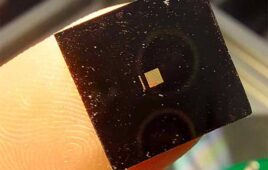A top medtech research site, the Boston-based Karp Lab has responded to COVID-19 with a virus-fighting nasal spray, better mask straps and much more.

Biomedical engineer Jeffrey Karp in his eponymous lab at Brigham and Women’s Hospital, Boston. (Image courtesy of Brigham and Women’s Hospital)
COVID-19 completely disrupted the work at Jeff Karp’s medical engineering lab at Brigham and Women’s Hospital in Boston. That’s not necessarily a bad thing.
One company that was planning to do research with Karp and his students pulled out; Canadian undergraduate students were called home by their government and couldn’t finish their experiments; postdoctoral students whose work was scheduled to end in June and couldn’t finish had to move on to other commitments. Undergraduate summer interns couldn’t start work because the hospital had imposed a hiring freeze.
Karp has chosen to look on the bright side.
“There’s a lot of challenges that we face but at the same time there’s a lot of opportunities that are arising,” said the Canadian-born bioengineer based at the Brigham and a professor of medicine at Harvard Medical School. “There are multiple new projects that have come out of this.”
The urgency to help patients and healthcare providers during the pandemic has enabled the Karp Lab — which has launched several companies over the years — to churn out technology that normally would have taken years to reach patients.
“With the pandemic here, everybody understands what the problem is and there are many aspects of the problem that need to be addressed and there’s an immediate need,” Karp said. “There’s been a loosening up of how quickly you can move things forward. It’s a big motivator to help people.
“There’s a lot of energy and passion. It’s easy now to find collaborators and bring people in and develop momentum on projects,” Karp added. “As problem solvers who have a lot of access to resources and incredible collaborators, we’re trying to think of everything we can to help in many different areas.”
For example, Karp and his team were already working on developing a nasal spray to create a physical coating that can deliver therapeutics. They pivoted that work from a different formulation to one that can kill SARS-CoV2, the virus that causes COVID-19. Made of materials from the U.S. Food and Drug Administration’s Generally Recognized as Safe (GRAS) list of materials, the spray would form a hydrogel barrier on the nasal mucosa to capture the virus and release viricidal agents to deactivate it.
Unless they’re wearing an N95 mask, which filters out nearly all airborne particles, people could use the gel to neutralize virus particles that enter their noses through gaps that form between their masks and their faces, Karp said. As a bonus, the gel would hydrate the nasal lining to help people breathe through their noses rather than through their mouths, leading to less fogging of glasses and perhaps more mask-wearing.
“We’re still in the process of putting together the data and will file a patent soon,” Karp said of the virus-killing gel research. “We envision this can have a relatively quick trajectory to get into use.”
The nasal spray research attracted $200,000 in funding from the Gillian Reny Stepping Strong Center for Trauma and Innovation at the Brigham. Plans are for it to be sold over the counter, so it wouldn’t need to undergo clinical trials, Karp said. The lab does, however, need a commercial partner to launch it.
Earlier in the pandemic, the lab team worked with athletic shoe manufacturer New Balance to fix the straps on 50,000 donated masks for use by frontline workers at the Brigham and its sister institution, Mass General.
Karp is now on different teams working on a COVID-19 detection approach, on how to re-purpose FDA-approved drugs to reduce the severity of COVID infections, and on developing a better non-medical-grade mask. The team has also begun to plan for normal lab activities to resume and to launch new, non-COVID research projects.
“I think it’s one of these things where people, in the front of their minds, are kind of hopeful that COVID will be gone in 6 months,” Karp said. “Probably — realistically — we’re going to be dealing with COVID for several more years to come.”




